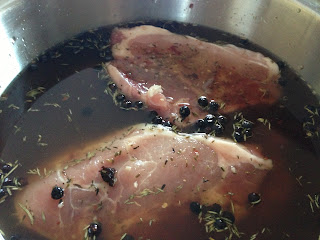I have brined chicken before, so I knew that this was going to be a delicious challenge but I wanted to do something a little different. I did a little research and decided to do a maple-brined pork chop. Anytime anything is titled "maple" anything, I'm in. Especially in November when you're just starting to realize that those 60 degree days aren't coming back for a long while. To me, maple just says comfort like sitting cuddled up in a blanket in front of the fireplace.
The added bonus of this recipe is that the brining solution called for Juniper berries. My dad (who is the king of unique ingredients) bought me some Juniper Berries to use and I just haven't had a chance to use them until now. If you're lucky enough to have a Penzey's (yes again...) they do have them there. Juniper berries can be used to flavor any type of game or something as simple as pork.
The roasted portion of our meal was a recipe that accompanied the maple brined pork chop recipe that I knew we had to have. The words "Roasted Pear Chutney" should just make your mouth water. The pears smelled unbelievable while they roasted in the oven, and the combination of that sweet, caramelized flavor with the vinaigrette is pretty cool.
Now I've done a lot of talking up of this recipe. On paper, I think it looks to die for. In execution, I'm not so sure. The pork came out just ultra salty and I was not a big fan of the chutney. Dave loved the chutney and was so-so on the pork. Perhaps my measurements were a bit off or something, but it doesn't mean the end of brining for us.
Maple-Brined Pork Chops (slightly adapted from Epicurious)
Brine
1 cup kosher salt
3/4 cup sugar
1 cup maple syrup
2 teaspoons hot red pepper flakes
2 tablespoons juniper berries
1/2 teaspoon whole cloves
1/4 cup fresh rosemary, chopped
2 tablespoons chopped fresh thyme
12 garlic cloves, smashed
2 tablespoons chopped fresh ginger
8 cups water
4 center-cut loin pork chops, 1 1/2 inches thick
Freshly ground black pepper
1. Mix all of the brine ingredients together in a nonreactive pot and bring to a boil. Turn off the heat and stir the brine to ensure that the salt, sugar, and maple syrup have dissolved. Let the brine cool, then put it in a large nonreactive container and add the pork chops. Cover and refrigerate for no more than 12 hours.
2. Remove the pork from the brine and pat dry (without rinsing). Season with pepper (no salt- they've already been brined!)
3. Heat 2 tbs of olive oil in a large skillet over medium high-heat. Sear the chops, about 2 minutes on each side. Watch carefully, as soon as they are browned flip them. Lower the heat and cover the pan. Allow to cook for a few more minutes on each side, until the chops register at least 145 on your meat thermometer. Remove from pan and allow to sit a few minutes before serving.
Roasted Pear Chutney (Epicurious)
2 ripe Bosc pears, peeled and cut in half
2 tablespoons freshly squeezed lemon juice
1/4 cup plus 1 tablespoon sugar
3/4 teaspoon ground cinnamon
1/4 teaspoon ground cloves
2 tablespoons vegetable oil
1/4 cup pure maple syrup
1 small red onion, cut into 1/2-inch slices
1 garlic clove, chopped
1 teaspoon grated fresh ginger
3 tablespoons golden raisins
1/2 cup white wine vinegar
1 teaspoon hot red pepper flakes
1 teaspoon chopped fresh thyme
1. Preheat the oven to 350°F.
2. Toss the pears with the lemon juice, 1 tablespoon of the sugar, the cinnamon, and cloves. Coat a sheet pan with half the vegetable oil. Set the pears cut side down on the pan. Brush the pears with the remaining oil. Roast until caramelized and tender, 40 to 50 minutes, depending on the degree of ripeness. Remove from the oven and allow to cool.
3. While the pears are roasting, bring the remaining ingredients to a boil in a nonreactive saucepan. Reduce the heat and simmer for 5 minutes. Remove from the heat and allow to cool.
4. Using a small spoon or a melon baller, scoop out the cores of the cooked pears. Cut the pears into 1/2-inch slices.
5. Combine the pears and the onion mixture. Cover and refrigerate for at least 1 day before serving.
The added bonus of this recipe is that the brining solution called for Juniper berries. My dad (who is the king of unique ingredients) bought me some Juniper Berries to use and I just haven't had a chance to use them until now. If you're lucky enough to have a Penzey's (yes again...) they do have them there. Juniper berries can be used to flavor any type of game or something as simple as pork.
The roasted portion of our meal was a recipe that accompanied the maple brined pork chop recipe that I knew we had to have. The words "Roasted Pear Chutney" should just make your mouth water. The pears smelled unbelievable while they roasted in the oven, and the combination of that sweet, caramelized flavor with the vinaigrette is pretty cool.
Now I've done a lot of talking up of this recipe. On paper, I think it looks to die for. In execution, I'm not so sure. The pork came out just ultra salty and I was not a big fan of the chutney. Dave loved the chutney and was so-so on the pork. Perhaps my measurements were a bit off or something, but it doesn't mean the end of brining for us.
Maple-Brined Pork Chops (slightly adapted from Epicurious)
Brine
1 cup kosher salt
3/4 cup sugar
1 cup maple syrup
2 teaspoons hot red pepper flakes
2 tablespoons juniper berries
1/2 teaspoon whole cloves
1/4 cup fresh rosemary, chopped
2 tablespoons chopped fresh thyme
12 garlic cloves, smashed
2 tablespoons chopped fresh ginger
8 cups water
4 center-cut loin pork chops, 1 1/2 inches thick
Freshly ground black pepper
1. Mix all of the brine ingredients together in a nonreactive pot and bring to a boil. Turn off the heat and stir the brine to ensure that the salt, sugar, and maple syrup have dissolved. Let the brine cool, then put it in a large nonreactive container and add the pork chops. Cover and refrigerate for no more than 12 hours.
2. Remove the pork from the brine and pat dry (without rinsing). Season with pepper (no salt- they've already been brined!)
3. Heat 2 tbs of olive oil in a large skillet over medium high-heat. Sear the chops, about 2 minutes on each side. Watch carefully, as soon as they are browned flip them. Lower the heat and cover the pan. Allow to cook for a few more minutes on each side, until the chops register at least 145 on your meat thermometer. Remove from pan and allow to sit a few minutes before serving.
Roasted Pear Chutney (Epicurious)
2 ripe Bosc pears, peeled and cut in half
2 tablespoons freshly squeezed lemon juice
1/4 cup plus 1 tablespoon sugar
3/4 teaspoon ground cinnamon
1/4 teaspoon ground cloves
2 tablespoons vegetable oil
1/4 cup pure maple syrup
1 small red onion, cut into 1/2-inch slices
1 garlic clove, chopped
1 teaspoon grated fresh ginger
3 tablespoons golden raisins
1/2 cup white wine vinegar
1 teaspoon hot red pepper flakes
1 teaspoon chopped fresh thyme
1. Preheat the oven to 350°F.
2. Toss the pears with the lemon juice, 1 tablespoon of the sugar, the cinnamon, and cloves. Coat a sheet pan with half the vegetable oil. Set the pears cut side down on the pan. Brush the pears with the remaining oil. Roast until caramelized and tender, 40 to 50 minutes, depending on the degree of ripeness. Remove from the oven and allow to cool.
3. While the pears are roasting, bring the remaining ingredients to a boil in a nonreactive saucepan. Reduce the heat and simmer for 5 minutes. Remove from the heat and allow to cool.
4. Using a small spoon or a melon baller, scoop out the cores of the cooked pears. Cut the pears into 1/2-inch slices.
5. Combine the pears and the onion mixture. Cover and refrigerate for at least 1 day before serving.








































